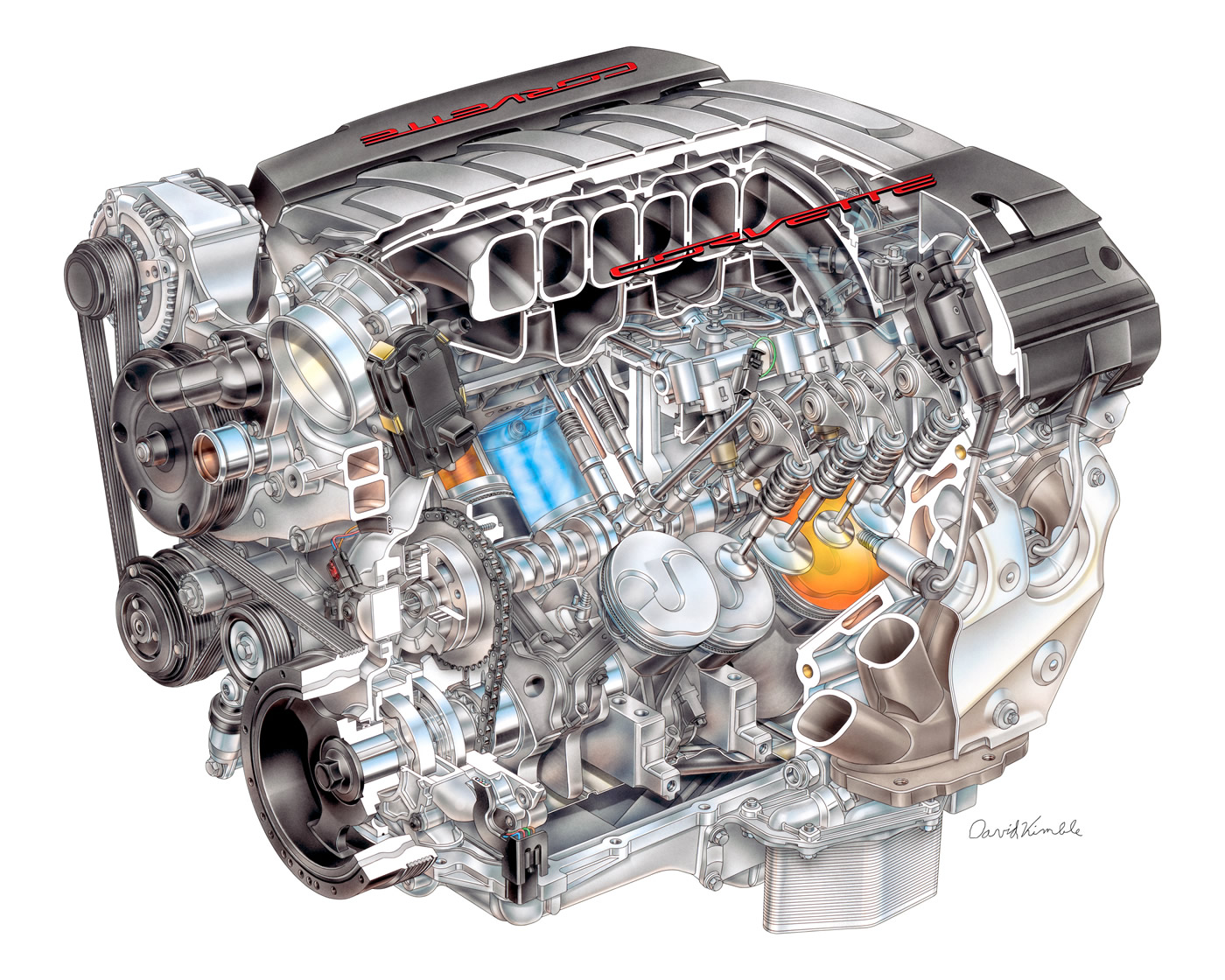2014 C7 Corvette LT1 Fact Sheet #1 - Gen 5 Small Block Combustion Driven by Advanced Analysis
Source: GM Media
Computational analysis on the Gen 5 Small Block that debuts in the next Chevrolet Corvette began five years ago and has consumed 0.1 quadrillion bytes of disk space on General Motors' computers. That's the equivalent of 18 billion typed pages or 23,000 DVD discs.
Much of the analysis was devoted to the engine's all-new advanced combustion system, which supports a trio of Next-Gen technologies never before used together on the Corvette, including direct injection, Active Fuel Management and variable valve timing. They contribute to preliminary output of 450 horsepower (335 kW), making the new 6.2L LT1 the most powerful and efficient standard engine ever offered in the Corvette.
Thirty analysts worked on the Gen 5 on their computers – including the development of all-new software – for several years before the first physical test engine was built, creating a design that is more volumetrically efficient than the Gen 4 Small Block. In addition to the advanced combustion system, they designed and evaluated every component in the engine, from the connecting rods to the rocker covers. They used a variety of commercially available software and proprietary software developed by General Motors.
Designers had to start from scratch when it came to the design of the Gen 5's new combustion system. The overhead valve arrangement and two-valves-per-cylinder arrangement was completely different than the DOHC design of GM's other direct-injected engines. The flow field – the motion of the air/fuel mixture – is more complex with an overhead-valve design and direct injection requires more mixture swirling for optimal combustion.
To deliver on the horsepower, torque and efficiency goals for the engine, they had to determine:
- The optimal placement of the injector in relationship to the spark plug within the combustion chamber
- The optimal size of the intake and exhaust valves – and the angles at which they'd be held in the cylinder head
- The size and volume of the combustion chamber
- The configuration of the piston head, which is crucial in supporting direct injection combustion.
More than 75 iterations of combustion systems for the Gen 5 were developed and evaluated through computational analysis, before a final design was selected. The resulting cylinder head configuration for the Gen 5 is all-new, along with a new, dished piston design. They work cohesively to exploit the high-compression, mixture motion parameters enabled by direct injection. Smaller combustion chambers complement the dish volume of the pistons' heads. The pistons also feature “risers” at the top to direct the fuel spray for a more complete combustion.
Another significant change is the reversal of the position of the intake and exhaust valves, compared to the Gen 4 Small Block. The change, which is supported by an all-new intake manifold design, enabled a straighter path for the air charge into the combustion chamber. The airflow enters the combustion chambers via large, 2.13-inch (54mm) hollow intake valves and exits through 1.59-inch (40.4mm) hollow sodium exhaust valves. The valves are held at new, 12.5-degree intake/12-degree exhaust angles, vs. the Gen 4's 15-degree angle, and they are splayed slightly to reduce shrouding and enable greater airflow.
Additional analysis-driven engine design features include:
- Knock performance was improved over the Gen 4 design, which enabled a higher compression ratio that supports greater power
- The spark plug was also moved closer to the center of the combustion chamber, pushing the flame for the combustion process closer to the center of the cylinder – an essential enabler of the direct injection system's efficiency
- The configuration of the exhaust port supports a minute amount of exhaust gases to be drawn back into the cylinder during the next combustion cycle, for a more complete burn that enhances efficiency and reduces emissions
- Displacement of the Corvette's LT1 engine was optimized at 6.2L for sustaining fuel-saving cylinder deactivation with Active Fuel Management, based on the car's weight and the engine's torque output
- Dozens of iterations of the wet- and available dry-sump oiling systems for the Corvette were evaluated to ensure optimal performance during the high loads of driving on a racetrack.
Computational analysis also drove mass optimization and noise-reducing initiatives with the Gen 5 Small Block, all of which supporting the implementation of the new combustion system. The direct injection system, for example, uses an engine-mounted, camshaft-driven high-pressure fuel pump. Because the feature had never been implemented on a Small Block, analysis drove the design of components such as the intake manifold, oil pan and more. The computer tests calculated the resonance of the components to predict their noise levels and “played” them against one another to determine probably noise and vibration sources. Component designs, including shape and sized, were refined until noise and vibration targets were achieved.
Inside the engine, the shapes and configurations of the rotating parts were evaluated for mass optimization, ensuring the highest quality and durability was achieved with the lightest, most efficient parts. When the need for a change was identified, it could often be implemented within a week, rather than several weeks or even months, when compared to evaluating physical components.
# # #
 |
